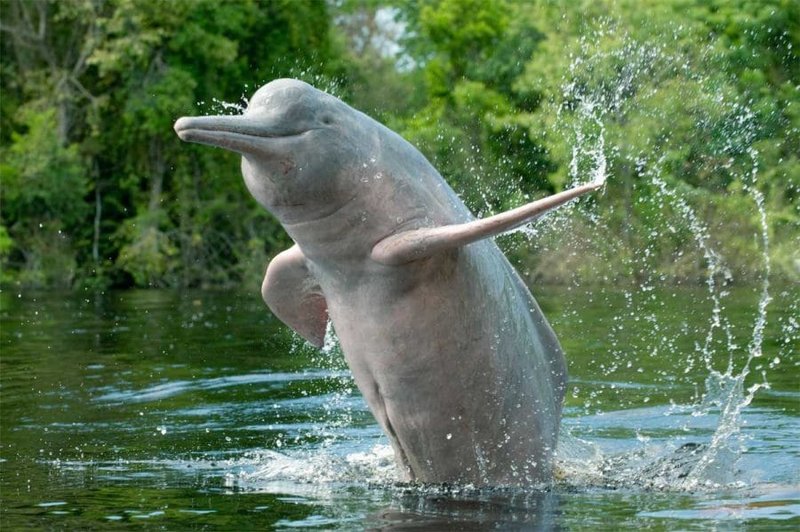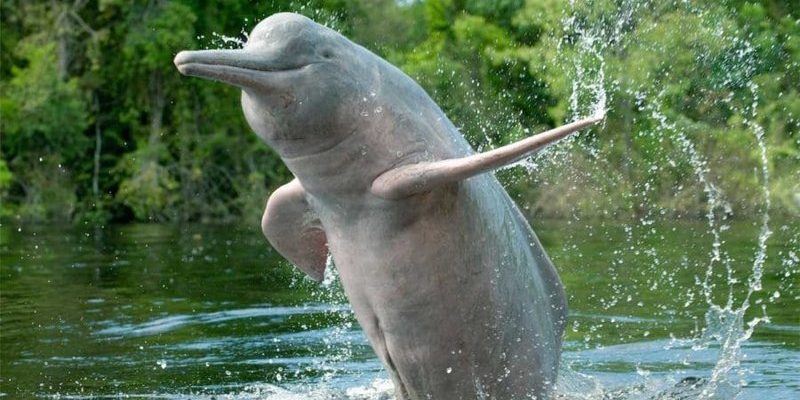
Imagine you’re sitting by the riverbank, watching these playful dolphins leap and twist in the water. You’re not just seeing a show; you’re witnessing a vital part of the Amazon’s food web. Understanding what these dolphins eat and how they find food can give us insights into their behavior, environment, and conservation needs.
Let’s unwrap the details about the Amazon River dolphin’s diet, what they like to munch on, and how their feeding habits adapt to their unique habitat.
What Does the Amazon River Dolphin Eat?
When it comes to the Amazon River dolphin’s diet, variety is the name of the game. These dolphins are opportunistic feeders, meaning they’ll eat whatever is available in their habitat. Their main diet consists of:
- Fish: They love fish, especially those found in the Amazon River, such as catfish and piranhas.
- Crustaceans: Shrimp and crabs are also on the menu.
- Small Mammals: Occasionally, they might even munch on small land mammals that venture too close to the water.
The Amazon River is like an all-you-can-eat buffet for these dolphins. With so much variety, they can pick and choose based on what’s seasonal and abundant. Imagine how it is for them, swimming through the water, spotting a tasty fish below, and using their echolocation to pinpoint it. It’s almost like playing a video game where you’re always on the lookout for your next meal.
How Do They Hunt for Food?
Hunting for food is where the Amazon River dolphin really shines. They have some pretty impressive skills. First off, they rely on echolocation. This is like their personal sonar. They emit clicks and listen for echoes to determine where fish are hiding, even in murky water.
Here’s the thing: they often work together in groups to herd fish into tight clusters. Picture a team sport where everyone plays a position. By corralling the fish, they make it easier to catch dinner. Sometimes they even use their bodies to create waves that scare fish into shallow areas, where they can feast without much effort.
Also, dolphins are known for their intelligence. They can remember the best fishing spots and adapt their strategies based on what works best. It’s like having a favorite coffee shop — once you find one you love, you keep going back.
The Role of Seasonality in Their Diet
The changing seasons have a significant impact on the food availability for the Amazon River dolphin. During the rainy season, the water levels rise, creating new habitats and access points for fish. Dolphins often follow the flooding patterns to find more plentiful feeding grounds.
Conversely, in the dry season, the water recedes, and food becomes scarcer. This forces dolphins to adapt their hunting techniques and travel further to seek out fish. They might spend more time in areas where fish are concentrated, like pools and lagoons. It’s fascinating how these creatures adjust their behavior based on the environment.
Imagine planning a picnic when you know the weather is unpredictable. You’d have to pack accordingly and maybe even change your location — the dolphins do just that in their watery world.
Impact of Human Activities on Their Diet
Human activities pose a significant threat to the feeding habits of Amazon River dolphins. Deforestation, pollution, and overfishing have altered their natural habitats and food sources. With rivers getting polluted, the fish that dolphins rely on can become contaminated, leading to health issues for the dolphins themselves.
Overfishing not only depletes the fish population but also disrupts the entire ecosystem. If their main food sources dwindle, dolphins might struggle to find enough to eat. This creates a ripple effect in the food web, affecting not only the dolphins but other species in the Amazon as well.
Let’s think about it: if you were trying to find your favorite food at a market that kept running out of stock, you’d be pretty frustrated, right? That’s what these dolphins are facing, and it’s a major concern for conservationists.
Conservation Efforts to Protect Their Diet
Thankfully, many organizations are working to ensure the survival of the Amazon River dolphin and its unique dietary needs. Conservation efforts include establishing protected areas to safeguard their habitats from pollution and habitat destruction. These sanctuaries provide a safe space for dolphins to thrive and find food.
Additionally, awareness campaigns aim to educate the local communities on sustainable fishing practices. By promoting biodiversity and preventing overfishing, these efforts help ensure that dolphins have plenty to eat. The more people understand the importance of dolphins in the ecosystem, the better chance these magnificent creatures have.
Just like you’d make a conscious effort to eat healthily and support local farmers, the same principles apply here. Protecting the dolphins’ diet is about maintaining a balance within the ecosystem.
In conclusion, the diet and feeding habits of the Amazon River dolphin are as intricate as the riverine landscape they inhabit. These dolphins are remarkable hunters, relying on their intelligence and echolocation to find a diverse range of foods, from fish to crustaceans. Their feeding habits are deeply intertwined with the seasonal changes of the Amazon and unfortunately impacted by human activities.
Protecting their diet means protecting the entire ecosystem, ensuring that these playful dolphins continue to thrive for generations to come. So, the next time you think of the Amazon River dolphin, remember it’s not just about their charming looks — it’s about their crucial role in the rich tapestry of Amazonian life. Let’s work together to keep their world flourishing.

